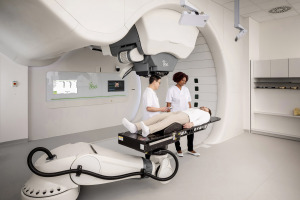by
John R. Fischer, Senior Reporter | October 03, 2022
From the October 2022 issue of HealthCare Business News magazine
In the next two years, UW Health, the health system associated with the University of Wisconsin, will be the first medical institution worldwide to clinically treat cancer patients sitting upright with proton therapy, using the Marie particle therapy system. Designed by Leo Cancer Care, the solution utilizes a rotating chair to allow the patient to sit in front of the proton beam, instead of lying down, creating a more comfortable body stance.
This naturally positions the heart, lungs, and other organs to reduce unnecessary radiation exposure, while allowing for more precise targeting of tumors. It also creates direct eye-to-eye contact between the patient and care team. Additionally, the scanner requires less space to install and reduces total cost of ownership, compared to other proton therapy systems.
“The significant innovation from Leo Cancer Care is the capacity to have a robotic upright positioning chair with six degrees of freedom that enables the chair to execute the movements that are necessary, rather than swing a big gantry around a patient to deliver the conformal beam,” radiation oncologist Dr. Paul Harari, chair of the department of human oncology at the UW School of Medicine and Public Health, told HCB News.
Several innovations like this are underway to not just improve the efficiency of proton therapy but expand its reach, accessibility, and affordability. HCB News sat down with Harari and other experts in the field to discuss these advancements, and how they are facilitating a greater ability to deliver optimal outcomes to cancer patients.
New innovations out today
About 20 years ago, the cost of setting up a proton therapy system was around $150 million. Today, most centers are paying $40 to $50 million, according to Harari. One reason has been a shift away from more expensive, traditional multiroom systems, to newer, single-room vaults.
The lower prices of these systems make building and the costs of infrastructure for a proton therapy facility more feasible, especially for smaller centers. These healthcare systems also usually have smaller volumes of cancer patients, which may justify investment in a single-room versus a multiroom system.
“The first- and second-generation proton centers were much more expensive. Several ended up going into bankruptcy because they couldn’t manage the business plan initially established. There is not nearly the same concern when dealing with just the single-room centers, which require fewer patients to be successful,” said Dr. Bradford Hoppe, medical director of particle therapy and professor of radiation oncology for Mayo Clinic Florida.
